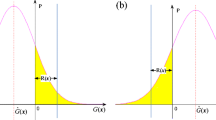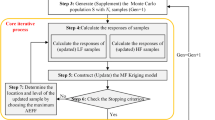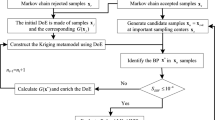Abstract
The huge computational cost is a main barrier of structural reliability assessment for complex engineering. Surrogate models can release the CPU burden of reliability assessment, however, it is very challenging to guarantee the prediction accuracy of failure probability. In this study, we propose an Adversarial Learning-Based Kriging model (ALBK), where two models learn from and compete with each other to achieve an improved model accuracy. First, the initial models are established, and fitting accuracy is evaluated by each other with the proposed criterion. Then, the modeling parameters are optimized according to the evaluation results. The data-driven criteria and adversarial relationship promote the evolution of modeling parameters. Moreover, a triple-indicator method is provided to choose the final model and avoid oscillation. The ALBK adjusts modeling parameters with alternative evolution, while the predicted values are more accurate than those of Kriging. Finally, an adaptive ALBK method is provided with new samples added to improve the accuracy of reliability assessment. Through several numerical examples, it can be seen that the ALBK always provides the best results with the fewest assessment calls, and the robustness is also good.
















Similar content being viewed by others
References
Arian NM, Fayazbakhsh K, Pasini D, Lessard L (2014) A comparative study of metamodeling methods for the design optimization of variable stiffness composites. Compos Struct 107:494–501
Bichon BJ, Eldred MS, Swiler LP, Mahadevan S, McFarland JM (2008) Efficient global reliability analysis for nonlinear implicit performance functions. AIAA 46:2459–2468
Chen GH, Yang DX (2019) Direct probability integral method for stochastic response analysis of static and dynamic structural systems. Comput Method Appl Mech Eng 357:11612
Chen ZZ, Qiu HB, Gao L, Li PG (2013) An optimal shifting vector approach for efficient probabilistic design. Struct Multidisc Optim 47(6):905–920
Echard B, Gayton N, Lemaire M (2011) AK-MCS: An active learning reliability method combining Kriging and Monte Carlo Simulation. Struct Saf 33:145–154
Echard B, Gayton N, Lemaire M, Relun N (2013) A combined importance sampling and Kriging reliability method for small failure probabilities with time-demanding numerical models. Reliab Eng Syst Saf 111:232–240
Goodfellow I, Pouget-Abadie J, Mirza M, Xu B, Warde-Farley D, Ozair S, Courville A, Bengio Y (2014) Generative adversarial nets. NIPS'14: Proceedings of the 27th International Conference on Neural Information Processing Systems 2:2672–2680.
Grooteman F (2008) Adaptive radial-based importance sampling method for structural reliability. Struct Saf 30:533–542
Hao P, Feng SJ, Zhang K, Li Z, Wang B, Li G (2018) Adaptive gradient enhanced kriging model for variable-stiffness composite panels using isogeometric analysis. Struct Multidisc Optim 58(1):1–16
Hao P, Ma R, Wang YT, Feng SW, Wang B, Li G, Yang F (2019a) An augmented step size adjustment method for the performance measure approach: Toward general structural reliability-based design optimization. Struct Saf 80:32–45
Hao P, Wang YT, Ma R, Liu HL, Wang B, Li G (2019b) A new reliability based design optimization framework using isogeometric analysis. Comput Method Appl Mech Eng 345:476–501
Hasofer AM, Lind NC (1974) An exact and invariant first order reliability format. ASCE J Eng Mech 100(1):111–121
Hong LX, Li HC, Gao N, Fu JF, Peng K (2021) Random and multi-super-ellipsoidal variables hybrid reliability analysis based on a novel active learning Kriging model. Comput Method Appl Mech Eng 373:113555
Hu Z, Mahadevan S (2016) Global sensitivity analysis-enhanced surrogate (GSAS) modeling for reliability analysis. Struct Multidisc Optim 53:501–521
Kim JH, Song JH (2020) Probability-adaptive kriging in n-ball (PAK-Bn) for reliability analysis. Struct Saf 85:101924
Kiureghian AD, Stefano MD (1991) Efficient algorithm for second-order reliability analysis. ASCE J Eng Mech 117(2):2904–2923
Lee TH, Jung JJ (2008) A sampling technique enhancing accuracy and efficiency of metamodel-based RBDO: constraint boundary sampling. Comput Struct 86:1463–1476
Lelièvre N, Beaurepaire P, Mattrand C, Gayton N (2018) AK-MCSi: a Kriging-based method to deal with small failure probabilities and time-consuming models. Struct Saf 73:1–11
Li X, Qui HB, Chen Z, Gao L, Shao X (2016) A local Kriging approximation method using MPP for reliability-based design optimization. Comput Struct 162:102–115
Li XL, Chen GH, Cui HC, Yang DX (2021) Direct probability integral method for static and dynamic reliability analysis of structures with complicated performance functions. Comput Method Appl Mech Eng 374:113583
Long T, Liu L, Li YL, Peng L, Huang B, Qi ZC (2012) Aero-structure coupled optimization of high aspect ratio wing using enhanced adaptive response surface method. 12th AIAA Aviation Technology, Integration, and Operations (ATIO) Conference and 14th AIAA/ISSMO Multidisciplinary Analysis and Optimization Conference.
Marelli S, Sudret B (2018) An active-learning algorithm that combines sparse polynomial chaos expansions and bootstrap for structural reliability analysis. Struct Saf 75:67–74
Marrel A, Iooss B, Laurent B, Roustant O (2009) Calculations of Sobol’ indices for the Gaussian process metamodel. Reliab Eng Syst Safe 94(3):742–751
Meng Z, Zhang DQ, Gao L, Bo Y (2019a) An importance learning method for non-probabilistic reliability analysis and optimization. Struct Multidisc Optim 59(4):1255–1271
Meng Z, Zhang ZH, Zhang DQ, Yang DX (2019b) An active learning method combining kriging and accelerated chaotic single loop approach (AK-ACSLA) for reliability-based design optimization. Comput Method Appl Mech Eng 357:112570
Meng Z, Zhang ZH, Li G, Zhang DQ (2020) An active weight learning method for efficient reliability assessment with small failure probability. Struct Multidisc Optim 61:1157–1170
Mirza M, Osindero S (2014) Conditional Generative Adversarial Nets. arXiv preprint.
O’Hagan A (2006) Bayesian analysis of computer code outputs: a tutorial. Reliab Eng Syst Safe 91(10–11):1290–1300
Ollar J, Mortished C, Jones R, Sienz J, Toropov V (2017) Gradient based hyper-parameter optimisation for well conditioned kriging metamodels. Struct Multidisc Optim 55:2029–2044
Ouellet F, Park C, Rollin B, Haftka RT (2019) A kriging surrogate model for computing gas mixture equations of state. ASME J Fluid Eng 141(9):091301
Qin H, Stewart MG (2020) Wind and rain losses for metal-roofed contemporary houses subjected to non-cyclonic windstorms. Struct Saf 86:101979
Ratliff LJ, Burden SA, Sastry SS (2013) Characterization and computation of local Nash equilibria in continuous games. Allerton Conference on Communication IEEE:917–924.
Song H, Choi KK, Lee I, Zhao L, Lamb D (2013) Adaptive virtual support vector machine for reliability analysis of highdimensional problems. Struct Multidisc Optim 47:479–491
Song XG, Lv LY, Li JL, Sun W, Zhang J (2018) An advanced and robust ensemble surrogate model: extended adaptive hybrid functions. ASME J Mech Des 140(4):041402
Stewart MG (2018) Reliability-based load factor design model for explosive blast loading. Struct Saf 71:13–23
Stewart MG, Li J (2021) Risk-based assessment of blast-resistant design of ultra-high performance concrete columns. Struct Saf 88:102030
Venter G, Haftka RT, Chirehdast M (1997) Response surface approximations for fatigue life prediction. 38 AIAA ASME ASCE AH.
Viana FAC, Haftka RT, Watson LT (2013) Efficient global optimization algorithm assisted by multiple surrogate techniques. J Glob Optim 56(2):669–689
Wang ZH, Ghanem R (2021) An extended polynomial chaos expansion for PDF characterization and variation with aleatory and epistemic uncertainties. Comput Method Appl Mech Eng 382:113854
Wei PF, Lu ZZ, Song JW (2014) Extended Monte Carlo simulation for parametric global sensitivity analysis and optimization. AIAA J 52(4):867–878
Xiao M, Gao L, Shao XY, Qiu HB, Jiang P (2012) A generalised collaborative optimization method and its combination with Kriging metamodel for engineering design. J Eng Design 23(5):379–399
Xu L, Cheng GD (2003) Discussion on: moment methods for structural reliability. Struct Saf 25:193–199
Xu J, Zhu S (2019) An efficient approach for high-dimensional structural reliability analysis. Mech Syst Signal Proc 122:152–170
Yi JX, Wu FL, Zhou Q, Cheng YS, Ling H, Liu J (2021) An active-learning method based on multi-fidelity Kriging model for structural reliability analysis. Struct Multidisc Optim 63:173–195
Yun WY, Lu ZZ, Jiang X (2018) An efficient reliability analysis method combining adaptive Kriging and modified importance sampling for small failure probability. Struct Multidisc Optim 58:1383–1393
Zhang Y, Han ZH, Zhang KS (2018) Variable-fidelity expected improvement method for efficient global optimization of expensive functions. Struct Multidisc Optim 58(4):1431–1451
Zhang JH, Gao L, Xiao M, Lee S, Eshghi AT (2020) An active learning Kriging-assisted method for reliability-based design optimization under distributional probability-box model. Struct Multidisc Optim 62:2341–3256
Zhao YG, Lu ZH, Ono T (2006) A simple-moment method for structural reliability. J Asian Archit Build Eng 5(1):129–136
Zhao L, Choi KK, Lee I, Gorsich D (2013) Conservative surrogate model using weighted kriging variance for sampling-based rbdo. ASME J Mech Des 135(9):091033
Funding
This work was supported by the National Natural Science Foundation of China (11772078 and 11825202), Fundamental Research Funds for the Central Universities, China (DUT2019TD37 and DUT20LAB203), Key Research and Development Project of Liaoning Province (2020JH2/10500003).
Author information
Authors and Affiliations
Corresponding author
Ethics declarations
Conflict of interest
On behalf of all authors, the corresponding author states that there is no conflict of interest.
Replication of results
The main step for building ALBK has been presented in Sect. 3. The process of the proposed adaptive ALBK method is shown in Sect. 4. The ALBK is written based on the DACE toolbox, and the main functions could be downloaded from the website: https://share.weiyun.com/iiK46OMI by using code x544yg.
Additional information
Responsible Editor: Chao Hu
Publisher's Note
Springer Nature remains neutral with regard to jurisdictional claims in published maps and institutional affiliations.
Appendices
Appendix
Derivation of Kriging
The predicted function of Kriging can be written as
where \(\omega_{i}\) denotes the weight coefficient of the ith response value. The regression function is defined as
where R is the kernel function of σ2and θ
where d is the number of dimensions, and \(x_{k}^{i}\) is the kth dimension of ith point. The mean squared error (MSE) at x is
In order to satisfy the unbiasedness constraint, the mean of the estimated error must be zero as follows:
So far, the weight coefficients can be calculated by solving the minimization problem about MSE(x) with the Lagrange multiplier approach. It can be found as follows:
And \(\mu\) is the Lagrange multiplier. Then, according to Eqs. (28) and (32), the following function can be obtained:
Also, Eq. (33) can be written as a matrix function as follows:
where
By solving Eq. (34), the prediction of unknown samples can be derived. As the samples have been adjusted to Eq. (27), the correlation matrix can be calculated easily. The correlation vector and the correlation matrix can be expressed as
The predicted MSE of \(\hat{y}\left( x \right)\) is
As both \(\hat{y}\left( x \right)\) and MSE are the functions of \(\sigma^{2}\) and θ, θ can be calculated by the maximum likelihood estimation approach. Because Z(x) follows the normal distribution, \(\hat{y}\left( x \right)\) follows the multidimensional normal distribution as
In order to obtain the maximum Ln(L), we can make the partial derivative about \(\sigma^{2}\) of this function to be zero to obtain the maximum evaluation. Take the partial derivative with respect to \(\sigma^{2}\) of this equation and set it as zero, \(\sigma^{2}\) and \({\varvec{\beta}}\) can be obtained as
The following function called ‘concentrated log-likelihood’ can be obtained, with which θ is calculated as follows:
Rights and permissions
About this article
Cite this article
Feng, S., Hao, P., Liu, H. et al. A data-driven Kriging model based on adversarial learning for reliability assessment. Struct Multidisc Optim 65, 27 (2022). https://doi.org/10.1007/s00158-021-03140-6
Received:
Revised:
Accepted:
Published:
DOI: https://doi.org/10.1007/s00158-021-03140-6




